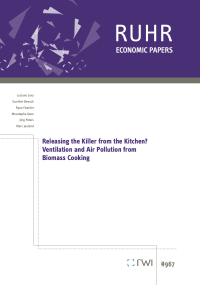Working Paper - September 2022
Releasing the Killer from the Kitchen? Ventilation and Air Pollution from Biomass Cooking
Household air pollution from biomass cooking is the most significant environmental health risk in the Global South. Interventions to address this risk mostly promote less-polluting stoves and clean fuels, but their diffusion proves difficult. This paper assesses the potentially complementary role of ventilation in reducing household air pollution. Using state-of-the-art measurements of kitchen concentrations of particulate matter (PM2.5) and personal exposure from 419 households in rural Senegal, we show that higher ventilation is strongly related to lower kitchen concentration, though absolute pollution levels remain high. This association is robust to controlling for a comprehensive set of potential confounders. Yet, these reductions in concentration do not translate into lower pollution exposure among cooks, probably due to avoidance behaviour. Our findings indicate that ventilation interventions may reduce smoke concentration nearly as good as many real-world clean stove interventions and can hence be an important complement to existing strategies. However, a more holistic approach is needed in order to reduce personal exposure in line with international health standards.
